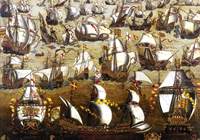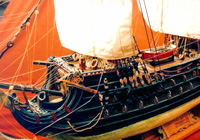Spanish Armada
Believing that God would support Catholic Spain over Protestant England, Felipe II planned to overthrow England to re-establish Catholicism and, as an added benefit, Spain’s uncontested control of the seas. Felipe II built up his allegedly “invincible” fleet and sent it off to attack, invade and capture England in 1588. The result? A crippling defeat.


Background of the Spanish Armada
The first and most important thing on Felipe II’s mind was the defense of Catholicism against its Christian rival Protestantism. The ultra-religious monarch was not at all happy with the religious movements in the Spanish Netherlands, in what is now Belgium and Holland. The Spanish Netherlands were leaning towards Protestantism, which was quite a big deal especially during this epoch when the rigidly pro-Catholic Spanish Inquisition was at large. Felipe II discovered that England’s famed Queen Elizabeth I was behind the scenes helping the Spanish Netherlands’ cause, further putting in danger Catholicism’s reign throughout the Spanish Empire.
The second of Felipe II’s motives was to reclaim Spain’s supremacy over trade and sea power. While Spain, following the discovery of America, was undoubtedly the most powerful country of the world, the ambitious Elizabeth I of England was aggressively trying to get in on the action and expand her empire. Needless to say, hers was a plan that interfered with Spain’s domination of the seas. Plus, men like Sir Francis Drake, a hero to England but a pirate to Spain, were intercepting and robbing Spain’s ships as they brought goods from America back to Spain. Felipe II’s reasoning was that if he were to rule over England, not only could he restore Catholicism but he could certainly restore Spain’s unrivalled power.
Organization of the Spanish Armada
The key to Felipe II's big plan was the massive fleet of 30,000 men and 130 ships from Spain and Portugal otherwise known as the grand Spanish Armada. That fleet would then link up to army troops in the Spanish Netherlands before launching the attack and subsequent invasion of England. The attack was widely advertised throughout England well in advance, a tactic that Felipe II and his advisors thought would spark fear in tiny England and essentially give in without any hassle.
He was wrong.
The Spanish armada, when sailing in crescent formation, was utterly invincible; however, should it fall out of formation, its vulnerability skyrocketed. That's exactly what happened. As the Spanish Armada approached their first stop - the Spanish Netherlands - they realized the water wasn't deep enough and anchored further offshore. However, something went amiss and two large fighting galleons fell out of formation. England - headed up by one rather famous Sir Francis Drake - quickly took advantage and captured two Spanish ships. From there things just went downhill for the Spanish Armada.
After fierce fighting, both sides essentially ran out of ammunition and the Spanish Armada's efforts had to come to a halt. Unable to pass back through the English channel due to their inability to defend themselves, then had to pass up and around England and Ireland before embarking for home. Facing a shortage of supplies, rough weather, heavy losses and debilitating illnesses, the goal of the Spanish Armada was simply to make it home in one piece.
When the Spanish Armada finally set anchor off the shores of Spain, only 67 of the original 130 ships and 10,000 of the original 30,000 men returned. Needless to say, not exactly what Felipe II had in mind.




